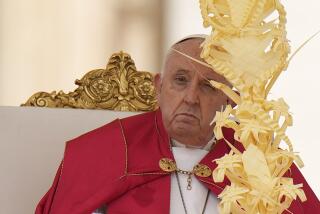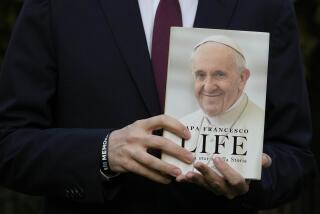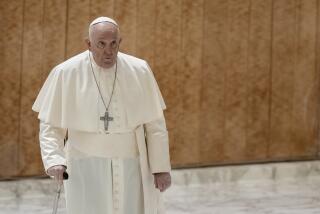A Pope Fading From the Scene
ROME â There have been blind popes and popes so sick they died within days of their coronation. And now there is a virtual pope, one who today will participate only symbolically in a cherished ritual of Roman Catholicism.
For the last two years, Pope John Paul II has been unable to walk or move easily. After an emergency throat operation last week, he can no longer talk, a condition that may or may not be permanent. And for the first time in a papacy of more than 26 years, the Vatican said Saturday, John Paul will neither appear nor utter prayers as part of the Sunday Angelus devotional.
What does an increasingly incapacitated pope mean for the broader Catholic Church, the oldest and largest house of Christianity?
Although most activities of the church can carry on normally without the intervention of the Holy See, the popeâs steady decline has forced him to delegate much authority to an ever-tightening, protective inner circle of senior officials. Even before his two emergency hospitalizations this month, the pope was seeing fewer visitors, writing fewer documents and slowing his once-formidable pace. It has become unlikely that any more bold initiatives, which once characterized this papacy, will be undertaken.
âThe irony is that the most active papacy in history is becoming the least active,â said the Rev. John P. Wauck of Romeâs Santa Croce Pontifical University.
As he fades, the business of the pope, and access to him, is controlled largely by four men:
* Cardinal Angelo Sodano is head of the powerful Secretariat of State, making him the equivalent of a prime minister and the No. 2 official at the Vatican. The Italian-born Sodano, 77, is seen as the consummate bureaucrat whose efficiency has complemented the popeâs vision.
Sodano fills in when dignitaries come to visit but the pope is sick, as was the case this month with U.S. Secretary of State Condoleezza Rice.
* German-born Cardinal Joseph Ratzinger, 77, is the ultra-conservative head of the Congregation for the Doctrine of the Faith, who serves as watchdog over church teachings. Some critics maintain that he has pushed doctrine further to the right than a fully engaged pope would have intended.
* Archbishop Leonardo Sandri, an Argentine, is the sostituto, the official who runs the day-to-day operations of the church and has the unique privilege of being allowed to see the pope without an appointment. He increasingly is the popeâs voice, frequently reading papal messages or homilies as John Paul sits, hunched, to one side. Sandri was scheduled to recite todayâs Angelus prayer to the public.
* Archbishop Stanislaw Dziwisz is easily the most influential of the popeâs aides. A fellow Pole, he is fiercely loyal to John Paul, whom he has served for about 40 years, since the popeâs days as a bishop in Krakow. He is always seen at the popeâs side, sleeps in a room next to the popeâs bedroom and is said to have a similar arrangement in the Gemelli Polyclinic, where John Paul is a patient. Dziwisz rides with the pope inside his vehicle and was famously seen cradling John Paulâs head after he was shot by a would-be assassin in 1981.
None of this inner circle is expected to ascend to the throne of St. Peter when John Paul dies, although Ratzinger has been mentioned lately as a possible long-shot papal candidate. Ratzinger and Sodano have been kept in their positions despite having passed the customary retirement age of 75, a testament to their importance to John Paul and to his reluctance to make significant personnel changes in the twilight of his pontificate.
Despite his lesser hierarchical standing, Dziwisz is the gatekeeper who decides who sees and does not see the pope, according to Vatican sources, and it is he who relays the popeâs decisions to others in the Curia, or administration.
The question on the mind of many observers is how many of the decisions are still being made by the pope. Vatican spokesman Joaquin Navarro-Valls insists that the pope is âstill in chargeâ and responsible for major decisions, but his condition makes this increasingly unlikely.
âDziwisz is the eminence grise of the circle that governs the church in the shadow of Pope Wojtyla,â veteran Vatican writer Sandro Magister noted, using the popeâs given Polish name. âInstructions arrive to those who must carry them out, not directly from [John Paul], but from the lips of his closest confidants, the only ones who have the authority to say, âThe pope wants this,â without providing any proof.â
There are only a few tasks that the pope alone must handle. Only the pope can teach infallibly. He must appoint bishops and canonize saints. When he was rushed to the hospital Thursday, the pope missed a ceremony naming saints for the first time in his papacy. He sent a note instead, saying he would watch via cable TV.
Mostly, the work of the Catholic Church hums along independent of the popeâs health, with legions of priests and bishops fulfilling the functions of a globe-spanning, well-structured organization. The Vatican itself is divided into departments known as congregations and councils, each with a certain degree of autonomy.
âIn many ways, the church runs itself,â said the Rev. Keith Pecklers of the Pontifical Gregorian University in Rome. âThe structure of the Roman Curia is deliberately organized in such a way that each office has its unique responsibilities, and so the situation is not alarming, because the departments and offices are for the most part making their own decisions.â
It becomes more problematic if the pope lingers, incapacitated but alive. Canon law does not provide for the removal of a comatose pope. A pontiff can retire, but he must do so of free will and fit mind.
Although it is widely believed that Dziwisz is making the medical decisions, the pope has no living next of kin and, officially at least, is not known to have written a living will with instructions.
âThe ability of modern medicine to keep the body alive while the mind is deteriorating will eventually present the church with a constitutional crisis,â noted the Rev. Thomas J. Reese, the Jesuit author of âInside the Vaticanâ and editor of the weekly magazine America. âAnd, despite church teaching that extraordinary means need not be used to keep alive a dying patient, who will have the courage to unplug the life-support systems of a pope?â
The absence of this pope is felt more keenly because he was such a high-profile leader. Silent now, John Paul intoned sermons before crowds millions strong. He scolded dictators and marched around the globe, television cameras often in tow.
âThe church is full of examples of popes who never spoke or appeared, not because they were incapacitated but because [visibility] was not the core of their mission,â said Alberto Melloni, a church historian with the University of Bologna.
âIt was John Paulâs decision to behave this way, to be a pope of the media.â
On Saturday, the Vatican did not provide updated information on the popeâs condition. The fact that he was missing public participation in todayâs Angelus was interpreted by Vatican watchers as a bad sign. During his numerous previous hospitalizations, the pope has always managed to wave a blessing from a window or issue a prayer, if only by radio or tape recording.
And, in contrast to the earlier hospital stay this month, the pope is apparently not receiving visitors. Several were turned away -- except for the members of his inner circle.
More to Read
Sign up for Essential California
The most important California stories and recommendations in your inbox every morning.
You may occasionally receive promotional content from the Los Angeles Times.











